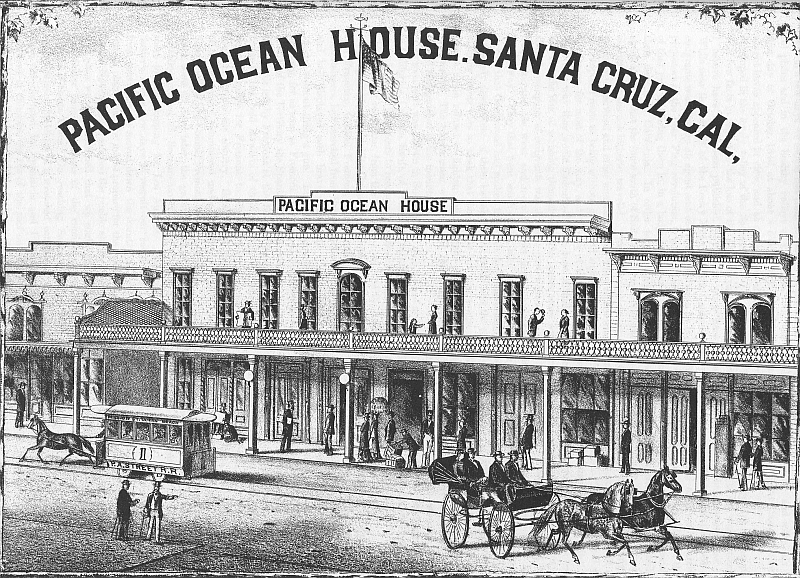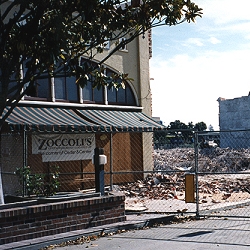History Pages: 22 - The Town
For a table of contents, see History pages.
1866 was the year Santa Cruz became a chartered town (not a city until 1875). Already in the midst of a post-Civil War building boom, it was another sign that the dusty old-west ranching town was rapidly growing up. The town charter of 1866 established a three-man (not to be sexist, but they were all men in those days) Board of Trustees to administer official business. The Board then selected one of its members to be President of the Board. The first President was S.W. Field, a downtown merchant soon to open for business in the 1867 St. Charles Hotel building (visible at the right of the 1880 photo of Mission Street on page 20 - The River).
The other Trustees were Amasa Pray, proprietor of the new Pacific Ocean House Hotel (1865, replacing the burned San Lorenzo House), and George C. Stevens. I haven’t found any information about Stevens, but notice that both Field and Pray were businessmen in the emerging lower downtown area. In 1867, Field’s spot on the Board was taken by Elihu Anthony, the original champion of the “lower plaza”.
Next door to the Pacific Ocean House (to the right as you face the front) was the property recently purchased by Alfred Baldwin. Baldwin was another of those who arrived in Santa Cruz just before the Mexican-American War. A native of upstate New York, Baldwin traveled overland to California via wagon train from Missouri, where he met another future Santa Cruzan, the tanner Richard Kirby. In 1846, he joined Fremont and marched to conquer Los Angeles in Thomas Fallon’s regiment, along with William Blackburn, Paul Sweet, Elihu Anthony and many other locals. After an unsuccessful trip to the gold fields in 1848, Baldwin returned to Santa Cruz and set up shop as a shoemaker and leatherworker in Blackburn’s Eagle Hotel building (the old adobe juzgado on the mission plaza). Next he bought a farm on Jose Bolcoff’s Rancho Refugio (now part of Wilder Ranch SP).
Baldwin apparently didn’t take to farming, for he soon sold the farm to Levi K. Baldwin (not related) and bought the Willow Street (soon to be Pacific Avenue) lot where he built a handsome 2-story brick building in 1866 for his leatherworking business. The style of the building coordinated with the hotel next door, and the upper floor was intended to serve as a meeting space for the hotel. That building still stands today as the oldest surviving downtown commercial building and home to Lulu Carpenter’s coffeehouse. The drawing at right (from Elliott) shows the hotel in 1879, with Baldwin's building to the right, after the addition of the broad porch roof.
Right across the street, Hugo Hühn (the brother of F. A. Hihn didn’t change the German spelling of the family name) built two modest new wood-frame buildings next to his “Flatiron” building. The southern-most of the two has survived earthquakes, fires and developers for more than 140 years, and has been since 1948 the home of Zoccoli’s Deli. A huge fire in 1894 destroyed most of the block, but the Flatiron, the two Hühn buildings, and three other buildings to the south were saved (the last one only partially). The three south-most surviving buildings were then incorporated into the new (in 1894) Hotaling building that became the St. George Hotel. The 1989 earthquake doomed both the Flatiron (the next-door building had been added to it) and the St. George Hotel, but the humble Zoccoli’s building was spared, and downtown lunchers remain grateful. The photo at left shows Zoccoli's after the earthquake and the subsequent demolition of the St. George Hotel (the fenced-off pile of rubble to the right).

